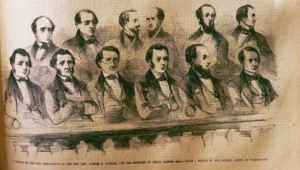Crazy like a Fox
As the trial proceeded, the question wasn’t whether a jury would find he committed the offense, but whether the panel could agree that his actions were prudent in the heat of the moment.
The answer soon came—the jury agreed that Sickles was incapable of discerning right from wrong at the time of the felony and was “not guilty” of the murder of Philip Barton Key.
Public opinion was split on the jury’s decision and many political allies not only abandoned but ostracized him as he returned to congress. He was an outsider which devastated his self-esteem. He knew there was no chance of re-election and he sat on the side bench in the legislative chamber and refused to participate in debate or to vote.
Perhaps the event that most damaged Daniel Sickles in the court of public opinion was his public forgiveness of Teresa for her transgressions. Many asked- if he could later forgive Teresa, why he could not have done so earlier and spared the life of Key?
Like so many things in Sickle’s life, the reconciliation with Teresa was more a public “media event” than an actual occurrence. Teresa was never again treated as a partner or confidant and had an unhappy and unloved existence until her death in 1867.
Sources:
Felix Fontaine. Trial of the Honorable Daniel E. Sickles (New York: De Witt, 1859), 106. W. A. Swanberg. Sickles the Incredible (New York: Scribner’s Sons, 1956), 105,106, 284.
